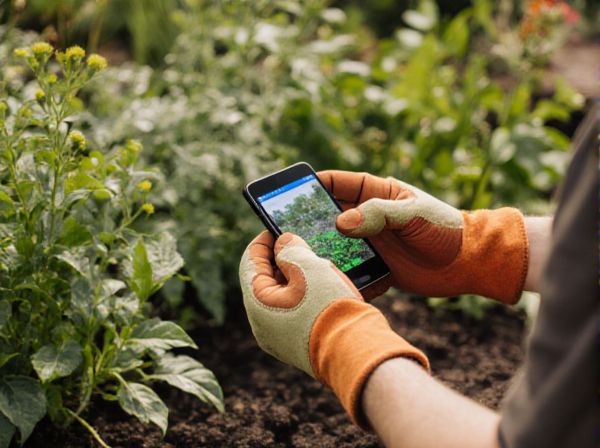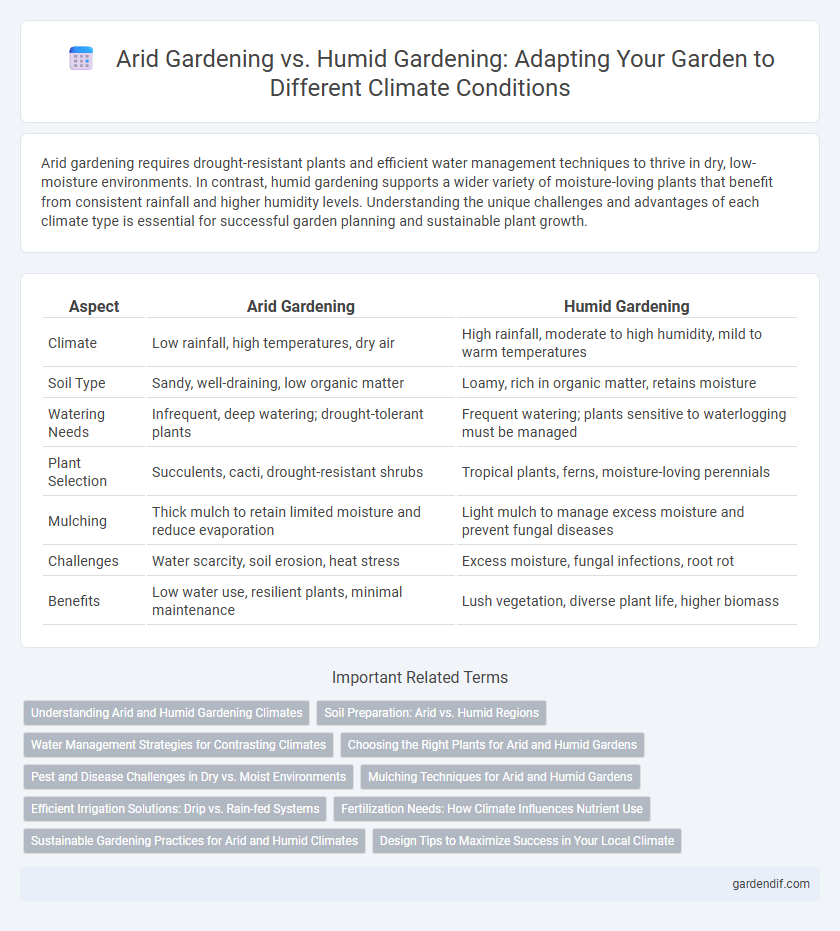
Arid gardening vs Humid gardening Illustration
Arid gardening requires drought-resistant plants and efficient water management techniques to thrive in dry, low-moisture environments. In contrast, humid gardening supports a wider variety of moisture-loving plants that benefit from consistent rainfall and higher humidity levels. Understanding the unique challenges and advantages of each climate type is essential for successful garden planning and sustainable plant growth.
Table of Comparison
| Aspect | Arid Gardening | Humid Gardening |
|---|---|---|
| Climate | Low rainfall, high temperatures, dry air | High rainfall, moderate to high humidity, mild to warm temperatures |
| Soil Type | Sandy, well-draining, low organic matter | Loamy, rich in organic matter, retains moisture |
| Watering Needs | Infrequent, deep watering; drought-tolerant plants | Frequent watering; plants sensitive to waterlogging must be managed |
| Plant Selection | Succulents, cacti, drought-resistant shrubs | Tropical plants, ferns, moisture-loving perennials |
| Mulching | Thick mulch to retain limited moisture and reduce evaporation | Light mulch to manage excess moisture and prevent fungal diseases |
| Challenges | Water scarcity, soil erosion, heat stress | Excess moisture, fungal infections, root rot |
| Benefits | Low water use, resilient plants, minimal maintenance | Lush vegetation, diverse plant life, higher biomass |
Understanding Arid and Humid Gardening Climates
Arid gardening climates are characterized by low annual rainfall, high evaporation rates, and extreme temperature fluctuations, requiring drought-tolerant plants and efficient water conservation methods like drip irrigation and mulching. In contrast, humid gardening climates have abundant rainfall, high humidity levels, and relatively stable temperatures, supporting lush vegetation but necessitating careful management of soil drainage and disease control to prevent root rot and fungal infections. Understanding these distinct climatic conditions helps gardeners select appropriate plant species and adopt tailored techniques to optimize growth and sustainability in both arid and humid environments.
Soil Preparation: Arid vs. Humid Regions
Arid gardening requires soil preparation that emphasizes moisture retention and aeration, often incorporating organic mulch, sand, and gypsum to improve water infiltration and prevent compaction. In contrast, humid region soil preparation prioritizes drainage enhancement through raised beds, organic matter addition, and soil amendment with sand or perlite to avoid waterlogging and root rot. Understanding these distinct soil management techniques is crucial for optimizing plant growth and sustainability in diverse climatic conditions.
Water Management Strategies for Contrasting Climates
Arid gardening employs water management strategies such as xeriscaping, drip irrigation, and mulching to minimize evaporation and optimize water retention in dry environments. In contrast, humid gardening prioritizes drainage systems, rainwater harvesting, and soil aeration to prevent waterlogging and fungal growth in consistently moist conditions. Tailoring irrigation techniques to specific climate needs enhances plant health and conserves water resources effectively.
Choosing the Right Plants for Arid and Humid Gardens
Selecting drought-tolerant succulents, native cacti, and deep-rooted shrubs suits arid gardens by maximizing water efficiency and soil conservation. Humid gardens benefit from moisture-loving plants such as ferns, tropical flowers, and broadleaf evergreens that thrive in high humidity and rich, well-drained soils. Matching plant species to climate-specific water availability and soil conditions ensures sustainable growth and vibrant garden health.
Pest and Disease Challenges in Dry vs. Moist Environments
Pest and disease challenges differ significantly between arid and humid gardening environments; arid gardens often face infestations from drought-tolerant pests like spider mites and aphids with fewer fungal diseases due to low moisture levels. In contrast, humid gardens encounter higher risks of fungal infections such as powdery mildew and root rot, alongside pests like slugs and snails that thrive in moist conditions. Effective pest management in arid settings emphasizes moisture conservation and pest-resistant plant varieties, while humid environments require vigilant fungal control and improved airflow to reduce pathogen proliferation.
Mulching Techniques for Arid and Humid Gardens
Mulching techniques for arid gardens prioritize water conservation using organic mulches like straw or wood chips to reduce evaporation and improve soil moisture retention. In humid gardens, mulch selections often emphasize breathable materials such as shredded leaves or compost to prevent excess moisture buildup and reduce fungal diseases. Effective mulching tailored to specific climate conditions enhances plant health, soil quality, and water management in both arid and humid environments.
Efficient Irrigation Solutions: Drip vs. Rain-fed Systems
Efficient irrigation in arid gardening relies heavily on drip systems, which deliver precise water amounts directly to plant roots, minimizing evaporation and conserving scarce water resources. In contrast, humid gardening benefits from rain-fed systems that utilize natural precipitation, reducing the need for supplemental irrigation and promoting sustainable water use. Choosing between drip and rain-fed irrigation depends on local climate conditions, water availability, and crop requirements to optimize plant growth and resource efficiency.
Fertilization Needs: How Climate Influences Nutrient Use
Arid gardening requires careful management of soil nutrients because dry climates limit organic matter decomposition, reducing nutrient availability and necessitating slow-release, water-efficient fertilizers. Humid gardening benefits from faster nutrient cycling due to higher microbial activity and moisture, making regular fertilization with balanced, soluble nutrients essential to support rapid plant growth. Climate-driven differences in moisture and microbial processes directly influence fertilizer type, application frequency, and nutrient uptake efficiency in arid versus humid garden environments.
Sustainable Gardening Practices for Arid and Humid Climates
Sustainable gardening practices in arid climates prioritize water conservation through xeriscaping, using drought-resistant native plants and efficient irrigation methods such as drip systems. In humid climates, sustainable gardening emphasizes managing excess moisture with rain gardens, selecting disease-resistant plants, and mulching to maintain soil health and reduce water runoff. Both approaches promote biodiversity and soil preservation tailored to the specific water availability and environmental challenges of their respective climates.
Design Tips to Maximize Success in Your Local Climate
Arid gardening design emphasizes drought-tolerant plants, efficient drip irrigation, and mulching to retain soil moisture, reducing water consumption significantly. Humid gardening requires careful plant selection for disease resistance, adequate spacing to improve air circulation, and soil amendments to prevent nutrient leaching and root rot. Incorporating native species and climate-specific landscaping techniques enhances plant resilience and overall garden sustainability in both arid and humid environments.
Arid gardening vs Humid gardening Infographic

 gardendif.com
gardendif.com